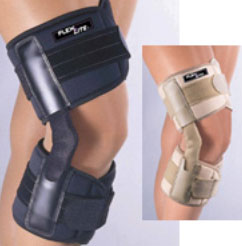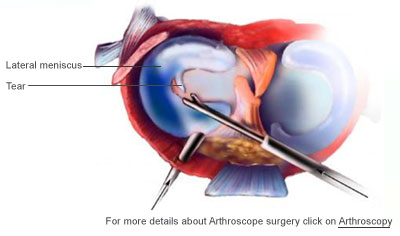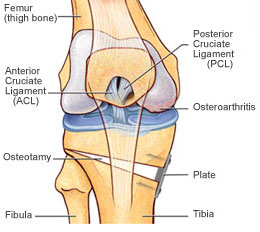The type of treatment chosen for a given patient depends upon the cause of arthritis, the stage of disease, the age of the patient and the patients’ functional expectations. Broadly the treatment options for arthritis can be categorized as follows:
(A) Non-surgical treatment
1. Oral Medication
2. Physiotherapy
3. Intra-articular Injections
4. Orthosis (Braces, Splints)
(B) Surgery
1. Arthroscopic Debridement (Key-hole surgery)
2. Open Arthrotomy & Joint Lavage (Joint wash out)
3. Osteotomy (Correction of Deformity)
4. Arthroplasty (Joint Replacement)
5. Arthrodesis (Fusion of Joint)
In most cases treatment is initiated with conservative (non-surgical) methods. Surgery is reserved for those patients who fail to respond to these methods of treatment or those with severe end-stage (degenerative) joint disease.
NON-SURGICAL TREATMENT OPTIONS ARE:
1) Oral medications used in arthritis include:
i) Pain relieving medicines (NSAIDs and analgesics)
These drugs help in reducing the pain and swelling in the joint. They do not have any specific effect on the arthritic process, and as such have a temporary effect. They may also have adverse side-effects like acidity, gastro-intestinal bleeding and kidney failure. Hence these medicines should not be taken on a long-term basis, and should be taken on the proper advice of your doctor. Some of the commonly used molecules in this category include Diclofenac, Aceclofenac, Etoricoxib, Ibuprofen, Piroxicam, Tramadol, Paracetamol etc.
ii) Disease Modifying Anti-Rheumatoid Drugs (DMARDs)
These are a group of specialized drugs which act specifically to suppress the inflammation in inflammatory arthritis like rheumatoid arthritis and ankylosing spondylitis. These drugs do have some side-effects and should to be taken strictly under guidance of your doctor. These are best administered under the guidance of a Rheumatologist, and need frequent monitoring (clinical examination and laboratory tests). Some of the commonly used molecules in this category include Methotrexate, Salazopyrine, Dihydroxychloroquine, Leflunamide, Etanercept etc.
iii) Nutritional Supplements (Mironutrients and anti-oxidants)
These are classified as nutritional supplements as they provide the necessary nourishment to the joint cartilage. These medications slow down the process of cartilage breakdown and the progress of the arthritic process. These medicines have to be taken for a prolonged period of time (at least 3-6 months) for the beneficial effects to be seen. These medications work best when administered in the early stages the disease, and may not have a significant effect when the joint is badly destroyed. Some of the commonly used medicines in this category include Glucosamine, Chondroitin, MSM, Diacerin, Vitamin-E etc.
2) Physiotherapy
Broadly speaking this consists of:
1. Modalities for relief of pain & swelling like SWD, USW, TENS, Interferential, Lasers etc.
2. Exercise programs for strengthening of specific muscles and improving the range of motion (mobility) in a joint
This has to be taken under the guidance of a physiotherapist who will choose the right type of modality and exercise program for a given patient. Physiotherapy can significantly relieve patients’ symptoms and improve function especially in the early stages of arthritis.
3) Intra-articular injections
These injections are given directly in the joint to relieve pain. They do not have any disease modifying effect on the joint and their effect is likely to be temporary. They have to be taken under advice of an Orthopaedic or Rheumatology specialist. These injections have to be given in clean environment (like the operation theatre) and utilizing strict aseptic precautions. The injections which are commonly used in the treatment of arthritis are:
1) Steroids injections (Hydrocortisone, Depomedrol)
These injections work as anti-inflammatory agents by reducing pain and swelling in a joint. In the past these injections were very popular in the treatment of osteoarthritis and rheumatoid arthritis when other modalities of treatment were not available. At present their role is limited to alleviating patients’ symptoms especially in cases with rheumatoid arthritis. It should be noted that these injections should not be taken repeatedly as there is risk of developing infection in the joint.
2) Hyaluronic acid injections (Visco supplementation)
These injections contain sodium hyaluronate which is one of the components of the joint cartilage. This is akin to re-injecting the lubricating fluid normally present in the joint. This is given as a single injection or as a course of three injections (depending upon the molecular weight of the chemical). These injections have to be given utilizing strict aseptic precautions usually in an operating theatre set-up. These injections are likely to give good and lasting pain relief when given in the early stages of osteoarthritis. In the later stages of the disease the effect of these injections is likely to be temporary.
4) Orthosis (Braces / Splints)

These include various braces and splints which are designed specifically for each joint. They help in relieving the pain and correction of deformity. They are usually not very helpful in patients with advanced stages of arthritis. They have to be used on a continuous basis, and sometimes are cumbersome to use.
SURGICAL OPTIONS FOR TREATMENT OF ARTHRITIS ARE:
1) Arthroscopic Surgery (Key-hole surgery/Minimally Invasive Surgery)
This is performed through two small cuts (incisions) made in the skin. An instrument called the arthroscope (an illuminated telescope) is inserted into the joint through one of these incisions and various micro-instruments inserted through the other incision to perform the required surgical procedure. The telescope is connected to a high resolution camera which projects a magnified view of the joint on a video monitor. Arthroscopic surgery when used in early stages of arthritis can give good long-term results. In advanced stages of arthritis it is used to for short-term relief of symptoms.

For more details about arthroscopic surgery click on ARTHROSCOPIC SURGERY
2) Open arthrotomy and lavage (Open surgical washout)
This involves opening up of a joint through a surgical incision (cut) to clear the joint of debris and washing it out. This is mainly reserved for patients with infective arthritis (pyogenic or tuberculosis). Since it involves opening the joint through a relatively larger incision the hospital stay and recovery may be prolonged.
3) Osteotomy
Osteotomy means cutting through a bone. In an arthritic knee osteotomy is usually performed to achieve correction of a deformity and to change the line of weight bearing at the joint. The commonest deformity in knee arthritis is the varus (bow leg) deformity. Osteotomy is usually performed in the upper end of the tibia (leg bone). The ideal candidate for this surgery is a young and active patient with arthritis affecting only one compartment of the knee.
4) Arthroplasty (Joint replacement surgery)
Joint replacement involves replacing the affected joint with an artificial joint (prosthesis/implant). Joint Replacement surgery is a very successful treatment option for a patient with severe arthritis causing pain and disability. At the present time joint replacement is a very successful and well established treatment option for severe arthritis of the hip, knee, shoulder and elbow.
For further details click on KNEE REPLACEMENT or HIP REPLACEMENT.
5) Arthrodesis (Joint fusion)
This involves fusing (joining together) the bony ends of a joint. This effectively means there is no movement occurring at the joint. Arthrodesis was one of the treatment options for treating an arthritic joint in the days prior to the advent of joint replacement surgery. At the present time it still has a place in the treatment of severe degenerative arthritis of the wrist, ankle and small joints of the hand, in the treatment of infective arthritis (like tuberculosis or pyogenic arthritis) in any joint, and in cases of recurrent (repeated) infection following joint replacement surgery.
